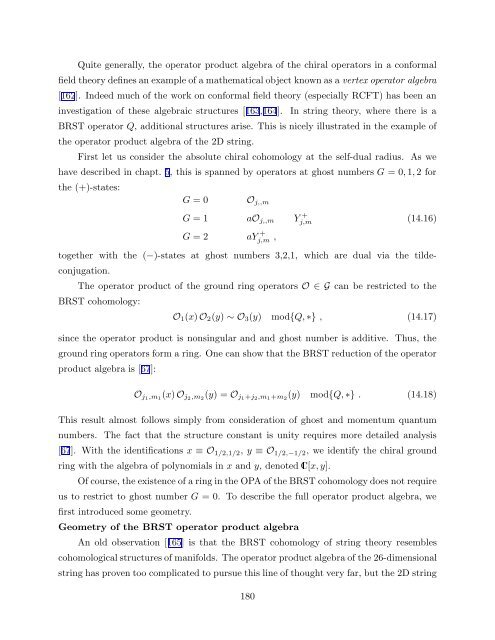arXiv:hep-th/9304011 v1 Apr 5 1993
arXiv:hep-th/9304011 v1 Apr 5 1993
arXiv:hep-th/9304011 v1 Apr 5 1993
Create successful ePaper yourself
Turn your PDF publications into a flip-book with our unique Google optimized e-Paper software.
Quite generally, <strong>th</strong>e operator product algebra of <strong>th</strong>e chiral operators in a conformal<br />
field <strong>th</strong>eory defines an example of a ma<strong>th</strong>ematical object known as a vertex operator algebra<br />
[162]. Indeed much of <strong>th</strong>e work on conformal field <strong>th</strong>eory (especially RCFT) has been an<br />
investigation of <strong>th</strong>ese algebraic structures [163,164].<br />
In string <strong>th</strong>eory, where <strong>th</strong>ere is a<br />
BRST operator Q, additional structures arise. This is nicely illustrated in <strong>th</strong>e example of<br />
<strong>th</strong>e operator product algebra of <strong>th</strong>e 2D string.<br />
First let us consider <strong>th</strong>e absolute chiral cohomology at <strong>th</strong>e self-dual radius. As we<br />
have described in chapt. 5, <strong>th</strong>is is spanned by operators at ghost numbers G = 0, 1, 2 for<br />
<strong>th</strong>e (+)-states:<br />
G = 0<br />
O j,,m<br />
G = 1 aO j,,m Y +<br />
j,m<br />
(14.16)<br />
G = 2 aY +<br />
j,m ,<br />
toge<strong>th</strong>er wi<strong>th</strong> <strong>th</strong>e (−)-states at ghost numbers 3,2,1, which are dual via <strong>th</strong>e tildeconjugation.<br />
The operator product of <strong>th</strong>e ground ring operators O ∈ G can be restricted to <strong>th</strong>e<br />
BRST cohomology:<br />
O 1 (x) O 2 (y) ∼ O 3 (y) mod{Q, ∗} , (14.17)<br />
since <strong>th</strong>e operator product is nonsingular and and ghost number is additive. Thus, <strong>th</strong>e<br />
ground ring operators form a ring. One can show <strong>th</strong>at <strong>th</strong>e BRST reduction of <strong>th</strong>e operator<br />
product algebra is [67]:<br />
O j1 ,m 1<br />
(x) O j2 ,m 2<br />
(y) = O j1 +j 2 ,m 1 +m 2<br />
(y) mod{Q, ∗} . (14.18)<br />
This result almost follows simply from consideration of ghost and momentum quantum<br />
numbers. The fact <strong>th</strong>at <strong>th</strong>e structure constant is unity requires more detailed analysis<br />
[67]. Wi<strong>th</strong> <strong>th</strong>e identifications x ≡ O 1/2,1/2 , y ≡ O 1/2,−1/2 , we identify <strong>th</strong>e chiral ground<br />
ring wi<strong>th</strong> <strong>th</strong>e algebra of polynomials in x and y, denoted C[x, y].<br />
Of course, <strong>th</strong>e existence of a ring in <strong>th</strong>e OPA of <strong>th</strong>e BRST cohomology does not require<br />
us to restrict to ghost number G = 0. To describe <strong>th</strong>e full operator product algebra, we<br />
first introduced some geometry.<br />
Geometry of <strong>th</strong>e BRST operator product algebra<br />
An old observation [165] is <strong>th</strong>at <strong>th</strong>e BRST cohomology of string <strong>th</strong>eory resembles<br />
cohomological structures of manifolds. The operator product algebra of <strong>th</strong>e 26-dimensional<br />
string has proven too complicated to pursue <strong>th</strong>is line of <strong>th</strong>ought very far, but <strong>th</strong>e 2D string<br />
180
















